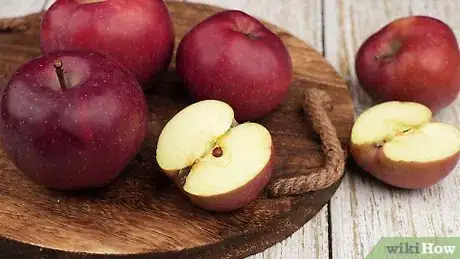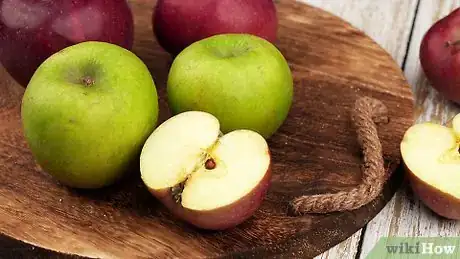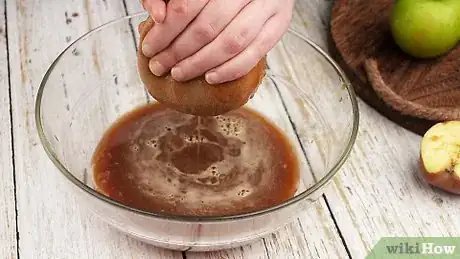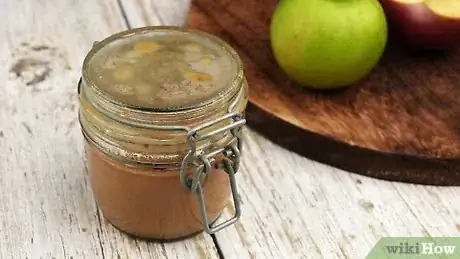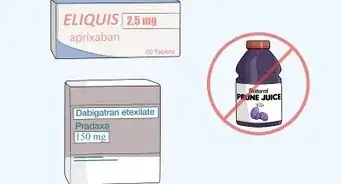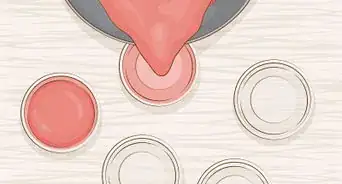wikiHow is a “wiki,” similar to Wikipedia, which means that many of our articles are co-written by multiple authors. To create this article, 46 people, some anonymous, worked to edit and improve it over time.
There are 9 references cited in this article, which can be found at the bottom of the page.
The wikiHow Culinary Team also followed the article's instructions and verified that they work.
This article has been viewed 991,705 times.
Learn more...
Nothing says autumn like a delicious glass of fresh apple cider. That crisp, tangy smell is a treat all its own, and aside from brilliant fall foliage, is one of the best treats of the season! But what if it's the dead of winter, and you have a desire for some fresh cider? This article will show you how to make fresh apple cider. See How to Make Hot Apple Cider for the heated version of cider.
- Total time (Non-Alcoholic): 30-45 minutes
Steps
Non-Alcoholic Cider
-
1Obtain the right apples. The best cider has a balance between sweetness and tartness. Often times, apple producers (who will often make their own brand of cider) will blend different apples together to get the right combination. Finding "your" blend is just a matter of experimentation, and experimenting will be a delicious endeavor! Here are some basic characteristics of common apple varieties:[1]
- Red Delicious: Large, firm red apple with a sweet flavor.
- Yellow Delicious: Large, firm yellow apple with a sweet flavor.
- Jonathon: Medium, crisp semi-tart apple, with red near the top, descending to green lower down the fruit.
- Granny Smith: Medium/small, crisp, tart apple with green color.
- Gala: Medium, crisp semi-tart apple with yellow skin blushed with orange to red tinge.
-
2Choose apples from the above list. Shop the local produce stands, fruit markets or grocery store shelves. If you lean toward a sweet juice, use a ratio of three sweet to one tart, or for medium sweetness, use a "two sweet to one tart" ratio. If you intend to make hard cider, use all sweet apples.
- It takes about one third of a bushel to make one gallon of cider.
Advertisement -
3Clean the apples thoroughly. Cutting out any bruises or damaged parts, and remove stems. As a rule, it is not recommended to use any fruit for cider that you would not eat as it is.
-
4Quarter the apples. Leave the skins on them for the color, flavor, and nutrients that processing will release.[2]
-
5Puree the apple quarters. Use a food processor or blender, and process till your apples have the consistency of applesauce.
-
6Strain the pulp. Squeeze the pureed apple through a cheesecloth, extracting all of the juice possible.[3]
- If you have a fine-mesh sieve or chinois, you can use the back of a spoon to press even more juice out.
-
7Always keep your cider refrigerated. After enjoying a tall glass of fresh apple cider, store the rest in a sealed container below 40 degrees Fahrenheit (5°C) for up to two weeks, or freeze for extended storage.[4]
Hard Cider
-
1Make cider. See above, and prepare enough sweet cider for five gallons.
-
2Get yeast. Visit your local brewing supply store, or look online for cider yeast. Dry wine yeasts are also a good choice, and are more common—and therefore, less expensive.
-
3Make a starter. A day or two before you plan on brewing your hard cider, make a yeast starter. This will ensure that your yeast is alive and ready to go, and will let you control the final flavor of your brew.[5]
- In a sealable jar, add one yeast packet to a half cup of your fresh apple cider. Seal the jar, give it a good shaking for five to ten seconds, then set it aside for five or six hours, or overnight.
- When you see it bubbling, release the pressure by partially twisting off the lid, then resealing the jar. Put the start in the refrigerator until a couple hours before you're ready to use it.
-
4Prepare your cider. Fill a stock pot or brew pot with fresh cider, and bring it to a very low simmer over medium heat. Continue simmering for about 45 minutes to an hour, to kill off any bacteria or wild yeasts that could alter the flavor of your cider.
- Do not boil the cider
- Add up to two pounds of brown sugar or honey to boost the sugar content, and make a harder hard cider!
-
5Prepare the fermentation bucket. To ensure that your bucket is clean and ready for hard cider making, sterilize it. Pour a capful of bleach into the bucket, fill with water, and let it sit while you finish simmering your cider. Empty the water, then rinse the bucket thoroughly with cold water.
-
6Pour the cider into the fermentation bucket. Let it cool until it's just warmer than room temperature, then add your starter. Stir with a sterilized spoon, then seal the lid and set the airlock.
-
7Let it ferment. Place the bucket in a cool, dark place—around 60° to 70°F (15° to 20°C). After a couple days, you should see the airlock start to bubble, as the yeast releases carbon dioxide. It should continue to bubble for a couple weeks. When it stops, let the cider rest for another week so that the yeast settles.[6]
-
8Bottle your cider. Using a clean, food-grade siphon, gently transfer the cider to sterilized bottles, seal them, and then let them sit for as long as you can stand it—at least a couple weeks. Like wine, hard cider will improve with age.[7]
Community Q&A
-
QuestionWhat is the difference between cider and vinegar?
 Community AnswerCider is like a fruit wine. Vinegar is when wine stands open to the air, ferments, and oxidizes the alcohol into acetic acid. Cider is alcoholic while vinegar is sour but non-alcoholic.
Community AnswerCider is like a fruit wine. Vinegar is when wine stands open to the air, ferments, and oxidizes the alcohol into acetic acid. Cider is alcoholic while vinegar is sour but non-alcoholic. -
QuestionHow can I make a clear, non-alcoholic apple cider?
 Dominic AntonacciCommunity AnswerUse a finer filter, such as a coffee filter. It's helpful to first filter it with the cheesecloth (like above), then run that through the coffee filter.
Dominic AntonacciCommunity AnswerUse a finer filter, such as a coffee filter. It's helpful to first filter it with the cheesecloth (like above), then run that through the coffee filter. -
QuestionHow much alcohol is hard cider likely to contain?
 Community AnswerThat varies depending upon the particular cider. It usually ranges from just three or four percent to upwards of 20 percent.
Community AnswerThat varies depending upon the particular cider. It usually ranges from just three or four percent to upwards of 20 percent.
Warnings
- Keep the processing equipment clean and sanitary.⧼thumbs_response⧽
Things You'll Need
- Apples
- Food processor, blender or juicer
- Cheesecloth sack or chinois
- Brewing equipment (see your local brewer supply store for specifics)
References
- ↑ https://www.pickyourown.org/applecider.htm
- ↑ https://www.thekitchn.com/how-do-you-slice-an-apple-69276
- ↑ https://www.euclidlibrary.org/tickle/apple-cider
- ↑ https://extension.oregonstate.edu/sites/default/files/documents/8836/sp50455preservingfruitjuicesapplecider.pdf
- ↑ https://www.motherearthnews.com/real-food/fermenting/how-to-make-hard-cider-zmaz07onzgoe
- ↑ https://www.themanual.com/food-and-drink/how-to-make-homemade-hard-cider/
- ↑ https://www.growforagecookferment.com/how-to-make-hard-cider-part-2-bottle-it/
- ↑ http://www.straightdope.com/columns/read/391/whats-the-difference-between-apple-juice-and-apple-cider
- https://www.thekitchn.com/whats-the-difference-between-apple-cider-apple-juice-word-of-mouth-178470
About This Article
To make non-alcoholic apple cider, choose about a third of a bushel full of your favorite apples, which will make a gallon of cider. You can mix tart and sweet apples to customize the taste of your cider, if you like. Wash the apples thoroughly, then cut them into quarters. Puree the apples in a food processor or blender until they have the consistency of applesauce. Squeeze the puree through a cheesecloth to extract as much liquid as possible, then serve your cider! Refrigerate whatever is left for up to 2 weeks. If you want to learn how to make a hard apple cider, keep reading the article!
